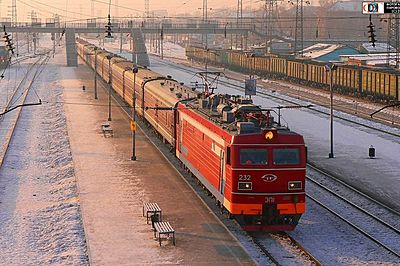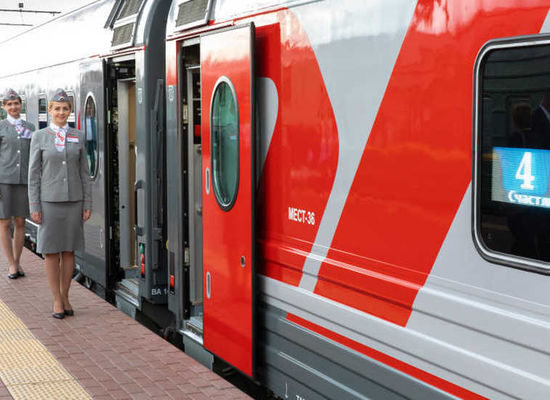Beijing to Moscow Trains
Beijing to Moscow Train Route
There are two train routes connecting Beijing to Moscow. The shorter one is 7622 km and it goes though Mongolia, hence its name, the Trans-Mongolian route. The longer one is 8961 km and it passes through Chita. Although it takes 1 day longer than the Trans-Mongolian, the advantage is that you don't need a Mongolian transit visa for the trip.
There is only one train running on the Beijing to Moscow direct route, which operates once a week. The same train runs on the Moscow to Beijing route. The trip takes 6 days. If you are looking for a shorter trip you may consider travelling to Moscow via Mongolia, but please remember that you will need Mongolian transit visa in this case.
Frequently Asked Questions From Our Travelers
Train #019/020 Beijing to Moscow takes the Trans-Manchurian route and doesn’t run through Mongolia so for this train, no visa is necessary.
The travel time between Beijing and Moscow is 6 days when you travel by the Trans Manchurian train #019/020 Beijing to Moscow.
Yes, there’s a restaurant car on the Beijing to Moscow train. The average price is $5-$20 per meal, the menu is not available online as it is different for each train and also changes throughout the year. Please note that RMB is accepted when the train runs through China and Roubles are accepted when the train runs through Russia.
No, this is not possible. According to the railroad office’s policy, if you would like to make stops during your trip you must purchase tickets to each city that you’d like to visit. The Russian railroad does not offer any flexible tickets with stopovers. We also highly recommend not to buy tickets on the spot, but plan your trip well in advance and book the tickets online as soon as they are available for purchase, usually 90 days before the trip.
Yes, you can travel with your pet in a 2nd class cabin. You will need to provide all the necessary veterinary documents and book all 4 berths in the 2nd class cabin.
Testimonials
“
Great service
Russ rail helped me plan and book a rail journey from Beijing to Moscow. They answered any questions without delay and were extremely patient with my very frequent additional questions and a number of changes I had to make before finally booking. It was a great trip - also thanks to the team at Russian Rail!
History of the Beijing to Moscow Train Route
The Trans-Manchurian Railway Facts
- This railway is a shortcut from Beijing to Moscow by train. It cuts through between Chita and Vladivostok. Construction lasted less than six years.
- This railway between China and Russia was the first transportation venture for the two countries. It stimulated economic development in Manchuria.
- The Trans-Manchurian caused and was used in conflict with Asian neighbors in the early twentieth century. In the 1950’s, China gained control of it from Russia.
- Today, the Vostok train runs weekly from Beijing to Moscow.
The Trans-Manchurian Railroad has a long and interesting history. Although once it was the key to solving transport and defensive problems in Eastern Russia, it now serves both practical and touristic purposes. Because the isolated and rural east lay so far from the seat of power in western Russia and needed rail connections, today travelers can leave from Beijing and reach the great metropolises of the west by rail in six days. Stopping overnight to see interesting cities and sights along the way makes for a great Asian and European mixed-cultural trip.
The task of connecting Moscow with the southeastern city of Vladivostok via railroad was underway at the end of the 19th century. The Russian Empire sought to empower and defend the isolated east as growing nearby Asian powers threatened this area. As the final eastern-most portion of the tracks became the next to be constructed, the Minister of Finance, Sergei Witte, proposed a shortcut through Chinese Manchuria. To save 550 kms-worth of track that wound around northeastern China, it would branch southward at the Russian city of Chita. In doing so, it would incorporate Chinese Beijing and Port Arthur (today part of the city of Dalian). This proposal for a shortcut on the line from Beijing to Moscow, was accepted and would be known as the “Chinese-Eastern Railway.” It was constructed between 1897 and 1903.
The harsh and unforgiving terrain of Eastern Russian and China complicated matters. Worse yet, the already constructed tracks stopped at the enormous Lake Baikal, where supplies had to be transported by boat. By volume, Lake Baikal is the largest freshwater lake in the world.
Did you know? The planned route around Lake Baikal wasn’t finished for another ten years. The original Trans-Siberian route did end in Vladivostok.
Because of complications with the lake, the city of Harbin became the center of construction. Harbin enjoyed a construction-related boom. European influences in construction make for an interesting Eur-Asian mix of cultures in Harbin. The railroad also stimulated underdeveloped Manchuria economically and attracted new inhabitants. In seven years, the population doubled to 16 million people. Several Chinese cities began surpassing Russia’s far eastern towns in terms of population.
Did you know? Harbin is now compared to St. Petersburg because of the work of Russian architects and urban planning by Swiss and Italian professionals.
The railroad opened in 1903. Eventually, three branches of the Chinese-Eastern Railway ended up with Harbin as a connection point. The southern arm went to Port Arthur and Beijing. The eastern branch reached Vladivostok. Chita was the end of the western branch. A trip on the fastest train from Port Arthur to Moscow cost between 64 roubles and 272 roubles, depending on the class of ticket and lasted over thirteen days. Today, only the western and southern branches are served by the Trans-Manchurian, so one can travel from Beijing to Moscow by train or from Port Arthur to Moscow.
This international railway became problematic in the twentieth century. In the Russo-Japanese War (1904-1905), Japan usurped the greater part of the southern tracks. In 1924, Soviet Russia gave up imperial claims in China. This included concessions in important places like Harbin. Still, Russia maintained control of the railway. In 1929, the Chinese gained control of the railway and expelled Soviet employees. The 1929 Sino-Soviet conflict was the result.
In 1952, the troubles with the southern branch came to a close. The Soviet Union relinquished control of the Chinese part of the Beijing to Moscow route. After decades of posturing and conflict, this transition indicated improved relations between the two communist powers.
Presently, in English, the route from Beijing to Moscow and the reverse are most often called the Trans-Manchurian Railway. Although the Trans-Siberian garners more attention, the Trans-Manchurian shouldn’t be undervalued. It passes through steppes and lively Chinese cities like Harbin, Shenyang and Beijing. The route’s duration has also shortened from thirteen days to six.
The Vostok train, meaning “East” in Russian, travels on the Trans-Manchurian route. A few years ago, Vostok trains received a renovation, although they do not rank among Russia’s most modern. They run about once per week from Beijing’s main station and Yaroslavsky Station in Moscow.
Did you know? Upon crossing the border into Russia, the train trades out a Chinese menu and cuisine for a Russian one.
Once you have your tickets, look forward to a wonderful, smooth
and enjoyable journey through the Russian countryside.
Buy your ticket safely and securely and then sit back
and enjoy the ride!
Recommended by
Our travel group under the names Express to Russia, Russian Rail and Trans-Europe Express has been recommended and/or accredited by:

A portion of your order goes to helping underprivileged Russian children.













